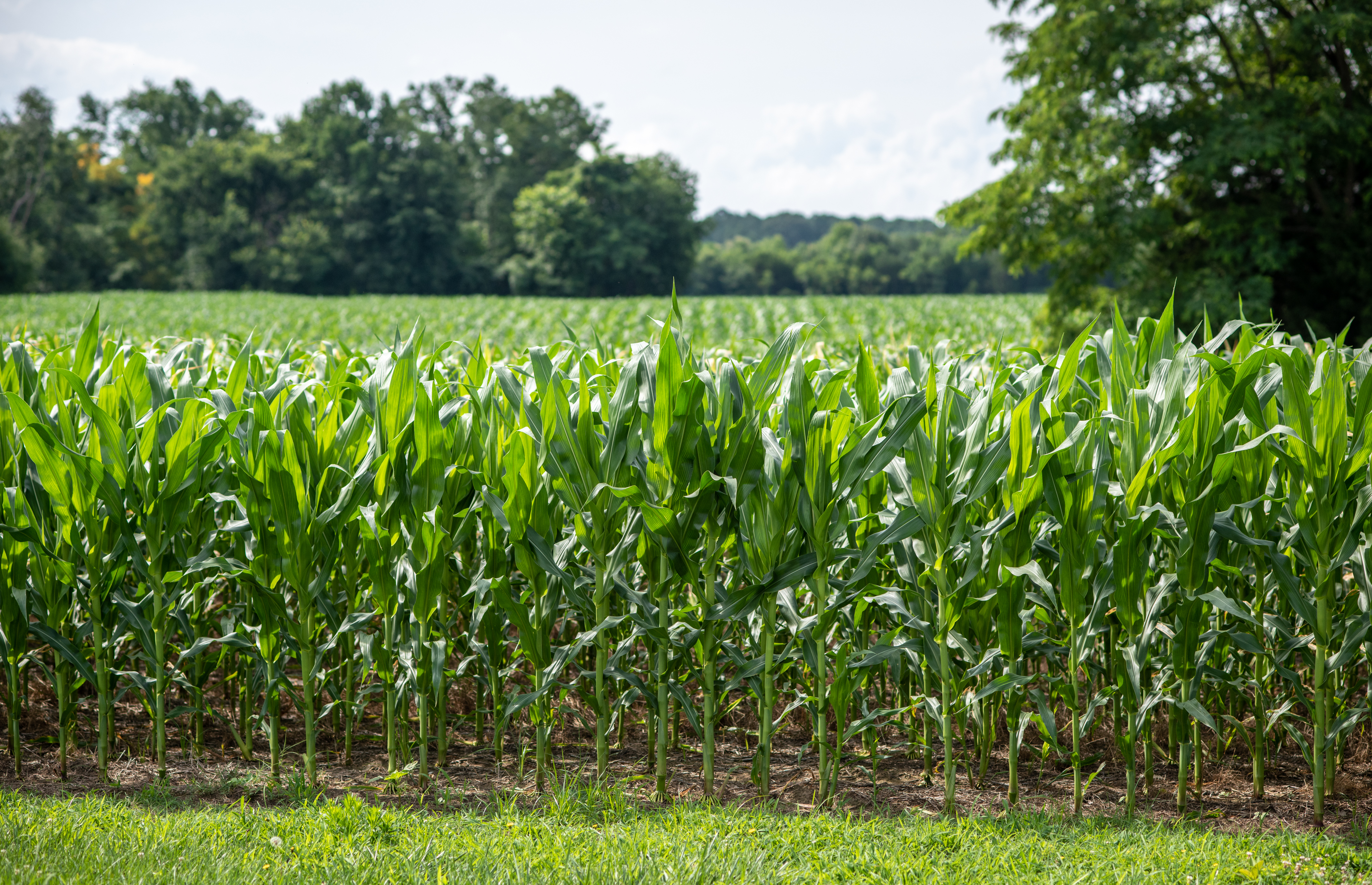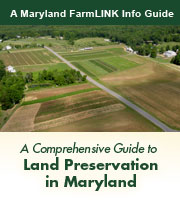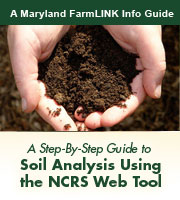
A Realtor’s Guide to Selling or Leasing Farmland
A Maryland FarmLINK Assistance Guide
Selling farmland is not the same as selling a house. With farmland, purchasers plan to operate a business. Farmers need to know whether or not a proposed acquisition will work within their business plan. They need to know if the soils are suitable and if there is adequate access to water. They need to know if there are any zoning regulations, covenants, easements or plat restrictions that would impact their proposed farm enterprise. They may want to know if Right-to-Farm regulations exist. Finally, they may want to know about special loans or grants available to Maryland farmers.
Helping farmers choose the perfect farm is complicated. Fortunately, there are resources online to help realtors find out more about soils, land use restrictions, right-to-farm provisions, lease/purchase options and other resources that purchasers and realtors need.
This project is supported by the Beginning Farmer and Rancher Development Program of the National Institute of Food and Agriculture, USDA, Grant #2012-49400-19552.
Evaluating Farm Soils
Evaluating Farm Soils
An open field is not always productive farmland. Soil characteristics, such as texture, drainage and distance to the water table, can vary greatly across a region, county or even a field. Some properties in Maryland have lost most of their topsoil to erosion and some have even been stripped of topsoil as part of a gravel mining or mineral extraction activity.
The USDA has online soils maps and data available for more than 95 percent of the counties in the United States. The Web Soil Survey provides soil classification and ratings that purchasers can use to evaluate the suitability for a type of farming operation. You may want to start with the Maryland FarmLINK Step-By-Step Soils Tutorial or you can go straight to the USDA Web Soil Survey if you are familiar with basic web mapping tools and understand soils nomenclature. Unless the farm is irrigated, a farmer will want to view the “non-irrigated capability class” under Land Classifications.
Some farmers may also want to conduct a soils test of a farm before purchasing. Soil testing provides a snapshot of the fertility level of the soil, including pH, Phosphorous, Potassium, Calcium, Magnesium, and the micro-nutrients. When selecting a farm, soil fertility is not as important as the inherent soil properties such as drainage or soil type. Poor fertility can be improved over time (2-3 years) with the addition of organic matter, manures, fertilizer, lime and other amendments. In Maryland, regulations limit the amount of manure, fertilizer, or other amendments containing phosphorous that can be applied to soils with excessive phosphorous fertility levels. This restriction should be a consideration by organic farmers who may not be able to use non-P bearing materials for Nitrogen sources. Soil structure, or how well the soil particles are held together, is another component of soil quality. Soil structure can also be improved over time with good management and the addition of organic matter.
Identifying Land Use Restrictions
Identifying Land Use Restrictions
Most open farmland with good soils in Maryland can be used for commodity crops. However, before a farmer signs a lease or purchases a property, it is best to be safe and determine if there are any zoning, covenant, easement, or plat restrictions, particularly if the farmer is considering direct farm sales or value-added sales (e.g. wineries, creameries, etc.), or agri-tourism (e.g. corn mazes, on-farm weddings, etc.). Restrictions may be found in many places:
Zoning ordinances. Each county zoning ordinance is different. However, most counties use similar zoning terminology and most in Maryland are available on-line, along with the zoning maps which define where the ordinances apply. A zoning tutorial is available on-line, along with links to county plans, ordinances and maps.
Covenants. A covenant “running with the land” is a written agreement, usually recorded in land records, that applies conditions to the use of property. To be fairly certain as to whether or not there are covenants on a property, your client may want to consult with an attorney about conducting a title search. However, you can do some initial research on your own by:
- Asking the owner or owner’s agent if there are covenants.
- Contacting the County Program Administrator.
- Going to Maryland AgPrint to see if the state maps indicate that the property is preserved by some form of covenant.
- Accessing Maryland Assessment records to find the deed for a property. Then to view the deed, set up an account here. Reading through the deed, you might find special covenants or conditions that apply to the land. This is by no means a failsafe method. The covenant may have been recorded after the deed was recorded or the attorney may not have mentioned the covenant specifically in the deed. However, the deed may contain some information that you may want to learn early in the property selection process.
Easements. People often think of an easement as a right of access over another’s property, which may be the case in some instances (see plat restrictions below). However, an easement can also be a written agreement which applies conditions to the use of property. To determine if there is an easement on a property, use the process outlined in “Covenants” above. Also, be sure to suggest that your client consult with an attorney about conducting a title search before purchasing a property.
Plat restrictions. If a property has been divided in the last 50 years or so, there may be a plat recorded in the land records. These plats may contain notes or conditions that are binding upon future owners of the property. Plat notes may indicate where access to the property is restricted, whether or not the property may be further divided, where a stormwater easement crosses a farm, and so on. Also, plat conditions may describe permit requirements, land clearing limitations, forest buffers from streams, etc.
Best Management Practices. Financial incentives are available for farmers willing to install best management practices to control soil erosion, manage nutrients, provide wildlife habitats, etc. The terms for some of the written agreements extend for years and apply to subsequent owners if the properties change hands before the agreements expire. Check out Maryland Department of Agriculture’s Financial Assistance Programs to learn more.
Agricultural Use Assessment. Properties meeting state criteria for agricultural use assessment are taxed at a lower rate. A property no longer farmed after receiving agricultural use assessment could be subject to the Agricultural Transfer Tax at some later date in the event of a transfer, sale, or other action “leading to or causing a violation of the agreement as contained in any Letter of Intent that may have been filed in order to receive the Agricultural Use Assessment”.
If a property is not currently receiving agricultural use assessment, a farmer may express interest in applying using this online application form.
Lease or Purchase?
Lease or Purchase?
Many beginning farmers lack the financial resources to buy land. Others would rather invest in their farm business than tie up all their capital on land purchase. Land leasing is a viable option in Maryland and realtors can help them negotiate the deal. The majority of farmland is currently leased on a year-to-year basis for grain or forage production. That may be changing, as more owners are interested in getting a share of higher crop prices that owners have been receiving in the last few years.
A disadvantage of leasing is that it is difficult to secure leases long enough to justify making improvements needed for the farm business to succeed. For these reasons, it is helpful to know your clients’ long term business plans and guide them accordingly.
Leasing Options. A written lease benefits both the farmers and land owners. With a well-constructed written lease, both parties have an understanding about the terms of use of the property, buildings, resources, revenue share, provisions for breaking the lease etc. A guide entitled “Agricultural Leasing in Maryland” provides a good background about preparing leasing agreements. It also includes sample lease documents.
Land Purchase Options. Many states have established land link websites to connect those who want to sell or lease farmland with those who want to buy or lease. In Maryland, we have the:
Loan options for land or infrastructure purchase: Resources are available at the federal and state levels, including:
- USDA loans
- Farm Credit (Congress established the Farm Credit System in 1916 to provide a reliable source of credit for the nation’s farmers and ranchers)
- Maryland Agricultural & Resource-Based Industry Development Corporation (MARBIDCO)
Land Preservation. While land preservation programs impose some limitations on the use of property (see covenants and easements above), they are the reason that much of the farmland still exists in Maryland. Being in a community of preserved farms provides stability and permanence. Farmers are more likely to invest in their farm enterprises if they know that neighboring farms cannot be developed. And if the land has not already been preserved, land preservation programs can be used to help a farmer pay off the loan.
Maryland has some of the best local and state land preservation programs in the country.
Landowner Conflicts
Addressing Conflicts with Land Owners
Recognizing the importance of farming to the state economy and culture, Maryland adopted enabling Right-to-Farm legislation. Most counties have adopted Right-to-Farm ordinances, which provide some protection for farmers from nuisance complaints. Right-to-Farm ordinances often include a local conflict resolution team to address land use conflicts before they reach the courts and the Maryland Department of Agriculture also has a Conflict Resolution Service.



